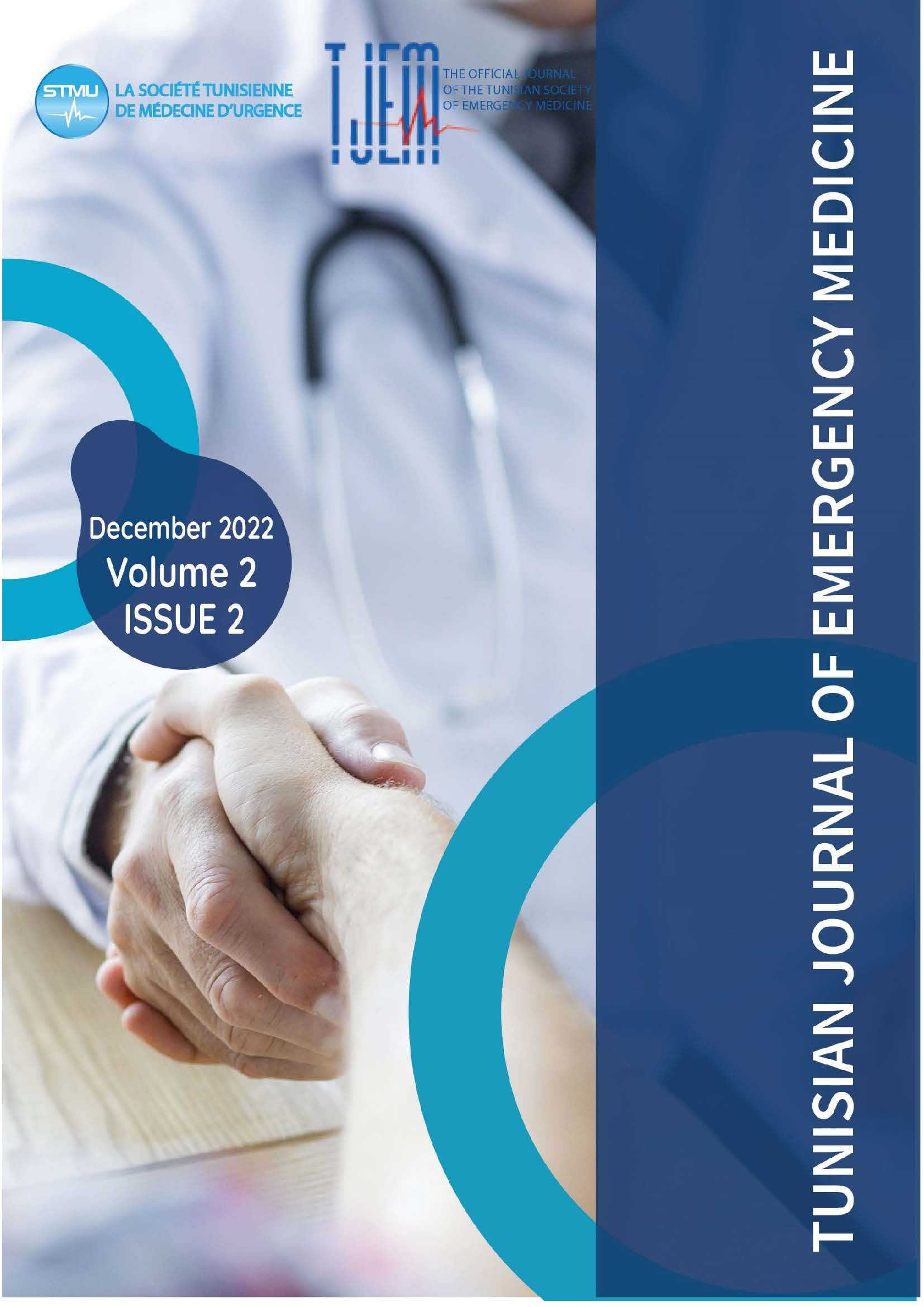Short and long-term outcomes of patients presenting with Acute Coronary Syndrome without ST-segment elevation (NSTE -ACS): findings from a Tunisian Register: the ReSCUS Register
Rahma JABALLAH, Hajer YAAKOUBI; Lotfi BOUKADIDA; Rym YOUSSEF; A BACCARI; Asma ZORGATI; Riadh BOUKEF
DOI:
https://doi.org/10.0000/p3kcxj09Keywords:
Acute coronary syndrome;, Emergency department, Management, DelayAbstract
Background: Chest pain is one of the most common complaints in the emergency department. Acute coronary syndrome with ST-segment elevation remains the ultimate medical emergency. However, acute coronary syndrome without ST-segment elevation (NSTE -ACS) has an equivalent prognosis risk. The major challenge of the emergency physician is the rapid and accurate identification of patients with ACS who would benefit from immediate care.
Objective:
Evaluation of our practices according to European Recommendations for the management of NSTEACS and assessment of short and long-term prognosis for major cardiovascular events (MACE).
Methods: This is an analytical study, involving 850 patients treated for NSTE-ACS for 2 years in the emergency department. Data were collected from the acute coronary syndromes’ local register (ReSCUS register). The main results were: the different delays in medical care, length of stay in the emergency department, short-term complications, and the occurrence of MACE registered at one month, six months, and one year later.
Results: The average age of our patients was 64 +/- 11 years. The sex ratio was 2.2. Hypertension and diabetes are the two most common risk factors in our population. NSTE-ACS was inaugural in almost a third of the cases. Only 7% of the patients have been referred to the ED by a medical team.
In 16.2% of cases, the initial ECG found no repolarization disorder. The average first medical contact delay was 24.4 +/- 30.2 min. The average first qualifying ECG delay was 30 +/- 0.6 min. The average length of stay in the emergency department before admission to the cardiology department was 24.1 +/- 21.3 hours. More than half of the sample (68%) had their angiograms within 48 hours. Among the 500 followed-up patients, 12 were completely lost. Patients who presented at least one MACE were
at one month: 58 patients (11.6%) at 6 months: 112 patients (22.4%), and at 1 year 136 patients (27.2%).
Conclusion: Cardiovascular disease is the leading cause of death worldwide. Assessment of our practices is important to improve prognosis. Registers offer a guarantee of methodology and are a real mirror of our medical care.
Downloads
Published
Issue
Section
License
Copyright (c) 2022 Tunisian Journal of Emergency Medicine

This work is licensed under a Creative Commons Attribution-NonCommercial-ShareAlike 4.0 International License.
How to Cite
Similar Articles
- Rim Karray, Kais Ben Jeddou, Hana Ksentini, Leila Chaari, Adel Chaari, Noureddine Rekik, The Perthes syndrome: a case report , Tunisian Journal of Emergency Medicine: Vol. 3 No. 1 (2025): TJEM 2025: Vol.3 Issue 1
- Fatma MHIRI, Aimen Dammak, Faiza Safi, Oumaima KHARDENI , Faten DHOUIB, Olfa chakroun-walha, Diagnostic Challenges and Treatment Strategies in Axillary Trauma: A Case Report , Tunisian Journal of Emergency Medicine: Vol. 2 No. 4 (2024): TJEM Vol2 Issue4
- randa dhaoui, A complicated pulmonary hydatid cyst mimickingpneumonia: A case report , Tunisian Journal of Emergency Medicine: Vol. 2 No. 4 (2024): TJEM Vol2 Issue4
- Rahma JABALLAH, A new practical score for early diagnosis of appendicitis in the emergency department , Tunisian Journal of Emergency Medicine: Vol. 2 No. 2 (2022): TJEM Vol2 Issue2
- olfa DJEBBI, Can we predict the clinical scenario of acute heart failure based only on NT proBNP rate without using echocardiography? , Tunisian Journal of Emergency Medicine: Vol. 2 No. 3 (2023): TJEM Vol2 Issue3
- Olfa chakroun-walha, Acute myocarditis complicating severe chloralose intoxication: A case report , Tunisian Journal of Emergency Medicine: Vol. 2 No. 3 (2023): TJEM Vol2 Issue3
- Cyrine KOURAICHI, Value of inferior vena cava diameter respiratory change as a marker of heart failure in COPD exacerbation , Tunisian Journal of Emergency Medicine: Vol. 2 No. 2 (2022): TJEM Vol2 Issue2
- imen REJEB, Spontaneous Pneumomediastinum as UncommonComplications of COVID-19 Pneumonia: 2 casereports and review of literature , Tunisian Journal of Emergency Medicine: Vol. 2 No. 4 (2024): TJEM Vol2 Issue4
- olfa DJEBBI, Acute cerebral insults in the emergency department: epidemiology and predictive factors of highly sensitive troponin level’s increase , Tunisian Journal of Emergency Medicine: Vol. 2 No. 3 (2023): TJEM Vol2 Issue3
- R. Obame, Serious abdominal traumatic emergencies in the emergency department of a “Trauma Center” hospital of Libreville (Gabon): Epidemiological, diagnosis and outcomes aspects , Tunisian Journal of Emergency Medicine: Vol. 2 No. 3 (2023): TJEM Vol2 Issue3
You may also start an advanced similarity search for this article.

